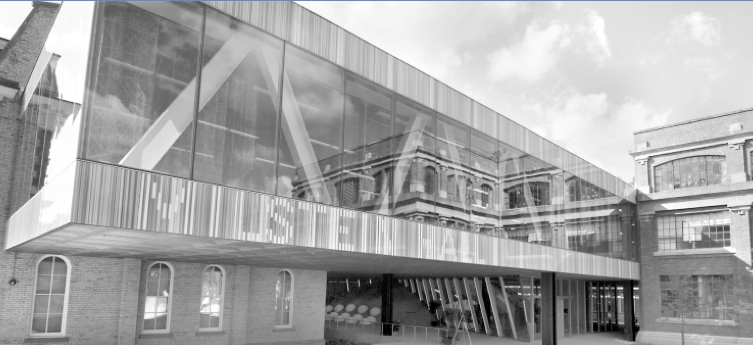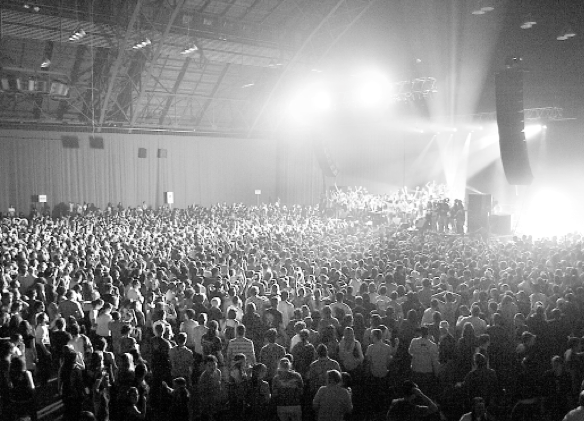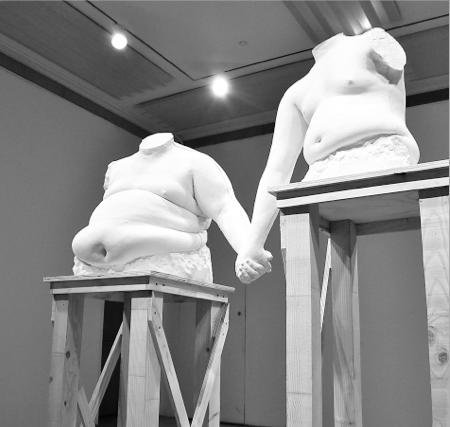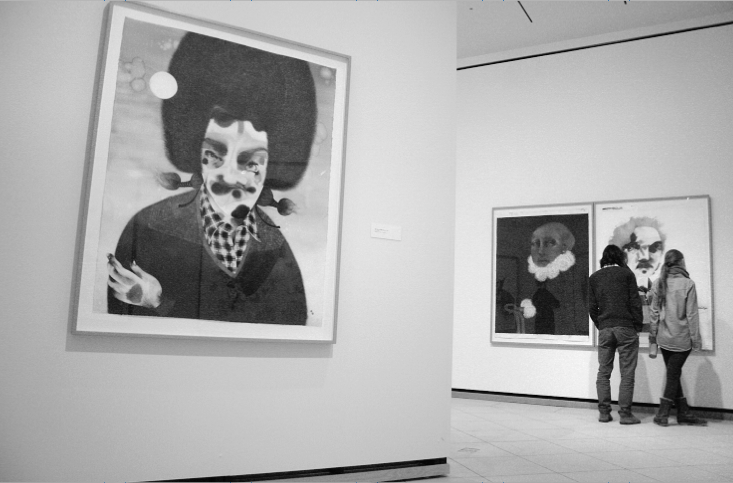IthacArts: Your guide to culture around campus — and beyond
So. You’re in college. In Ithaca. What to do now?
When prelims, lab reports and snow aren’t getting you down (read: seldom), there’s a lively arts scene right outside your doorstep to keep you sane. From barn-burning bashes in Barton to art appreciation in the Johnson, there’s something for every taste. Cornell may be known for its cows and gorges, but it’s no slouch when it comes to music, theater, film and fine art.
And don’t forget the turf around The Hill. Ever since it made an appearance in Homer, Ithaca has been an arts-obsessed little town, with a local music scene bursting at the seams and a host of other cultural offerings to keep the hippies, hicks and Hillsters entertained. So make use of your time here, hit the town and remember — grades may last a semester, but art lasts forever.

Show Promoters
Cornell Concert Commission | The heavy hitters in the campus concert scene. They’re the ones responsible for the big blowouts at Barton (Wavves, Avicii, etc.) and the early fall show on the Arts Quad. Now you know where your Student Activity Fee goes.
Fanclub Collective | The Lennon to CCC’s McCartney and a home to Cornell’s wannabe Brooklyn hipster crowd, Fanclub brings in bands before they’re cool and offers an oasis of originality in the desert of Cornell’s musical conformity. Think Real Estate, HEALTH and Shonen Knife. If you get it, you get it.
Slope Day Programming Board | They only put on one show a year, but don’t call them lazy: these cats work year-round to throw Cornell the biggest and baddest party around, and the music’s just half of it. Feeling woozy? Thank your lucky, Slope Day Programming Board stars that there’s free water (and port-o-potties) within crawling distance.
Concert Venues
The State Theatre (107 W. State St.) | The State is Ithaca’s very own Fillmore, MSG and Royal Albert Hall, all rolled into one. A cinema following Ithaca’s brief tenure as the Hollywood of the East, its ornate interior has recently played host to the likes of The X Ambassadors, Bo Burnham and Norah Jones. Glass Animals, David Sedaris and The Wombats are just a few of the acts slated to stop by this season. Be sure to get your tickets early.

Barton Hall (Central Campus) | There might be track and field equipment on the floor and ROTC classrooms for a backstage, but Barton is a bona fide big star attraction. Ever heard of Carly Rae Jepsen, Young Thug or Trevor Noah? They’ve all stopped by the last few years, and Barton Hall is the undisputed king of campus venues, with a capacity around 5,000 and … interesting acoustics. One other quirk: most shows are on Sunday nights — the track team gets Barton on Saturdays.
Bailey Hall (Central Campus) | If you want to hear the sweet sounds of the Cornell Symphony Orchestra or the thoughts of Nobel Prize winners such as Elie Wiesel and Toni Morrison, then Bailey’s your best bet. The classroom for some of Cornell’s largest classes doubles as a venue for more subdued performances.
Risley Hall (North Campus) | As with all things arts-related on campus, Risley Hall is right in the thick of the concert scene, hosting smaller acts like The Pains of Being Pure at Heart in years past, while welcoming Cornell’s own singers and songwriters to rock their halls. Risley also plays host to student productions, and is home to the annual showing of The Rocky Horror Picture Show.
The Bars (Downtown & Collegetown) | For a more intimate live music experience, be sure not to miss the thriving bar music scene around town. The Nines in Collegetown regularly features Cornellians. Ithaca Underground, a nonprofit supporting Ithaca’s local music community, brings over 40 shows to the city every year. The Haunt (702 Willow Ave.) constantly hosts acts small and large, including Raekwon and Rusted Root. Watering holes like Felicia’s Atomic Lounge (508 W. State St.) and the Sacred Root Kava Lounge & Tea Bar book acts throughout the year.
The Slope | The epicenter of madness and debauchery on campus … at least for one day a year. The headliner last year was Galantis, joining an already impressive roster that includes Chance the Rapper, Kanye West and Drake. It gives you something to look forward to during the long, cold winter.
Drama
The Schwartz Center for the Performing Arts (430 College Ave.) | The home of Cornell’s Performing and Media Arts department hosts campus-produced plays, musicals, movies and dance performances throughout the fall and spring in addition to can’t-miss annual events such as Festival 24.
Risley Hall (North Campus) | Risley’s drama-oriented denizens give Cornell plenty to laugh, cry and think about, offering everything from nights at the circus to period-faithful reproductions of Don Giovanni.
Other Theaters | Even with all of the campus offerings, there’s a thriving drama scene in the city of Ithaca. The Kitchen Theatre (417 West State St.) offers classical and modern productions year-round and the newly renovated Hangar Theatre (801 Taughannock Blvd.) performs for those lucky enough to stay for an Ithaca summer. Speaking of which, the Ithaca Shakespeare Company puts on Shakespeare in the Cornell Plantations in July.
Art Galleries

Johnson Museum (Central Campus) | The Herbert F. Johnson Museum of Art, Cornell University’s own fine art museum located conveniently on the Arts Quad, has a prolific collection of contemporary and historic works of art, including many Asian artifacts. The temporary galleries change almost monthly and the Johnson frequently hosts events and lectures related to the works shown. Less known is the fact that the Johnson owns many more works than it can show at any given time: hidden in the archives are more Hokusai prints, original Rembrandt plates and the paintings of abstract expressionists like Michael Goldberg. These works are available for viewing to students — an awesome privilege — and can be seen by making an appointment with a curator. Also, once a year, the History of Art Majors Society, a student run group, curates a show accompanied by essays and interactive exhibits.
Hartell Gallery, Sibley Hall (Central Campus) | Architecture students are notoriously mysterious, always locked up in Rand Hall producing God knows what. Hartell Gallery is a little known way of sneaking a peek at their curriculum. Nestled under the dome in Sibley Hall, the (spatial) center of the AAP community hosts a range of exhibits throughout the year. During mid-terms and finals, stop by to see the studio works of students pinned up — not just drawings of buildings, but frequently hand-built models and constructed work.
Tjaden Hall (Central Campus) | Cornell conceals a small but productive discipline in the fine arts within its College of Architecture, Art and Planning. While you’re in Ithaca missing the big shows at big city museums, the two galleries at Tjaden Hall put on constantly changing exhibits throughout the year — a glimpse into the current discourse on campus. In years past, exhibits have offered everything from huge plaster casts of bulging bodies to delicate paintings of Iraqi aerial landscapes. The Olive Tjaden Gallery and the Experimental Gallery are open during the week; check at the AAP registrar’s office for a schedule of shows.
Architecture
Milstein Hall (Central Campus) | Nope, that’s not a U.F.O. — Milstein Hall, designed by Pritzker prize-winning architect Rem Koolhas and conceived as the home to Cornell’s esteemed architecture program, is a dazzling and starkly modern architectural marvel. The 47,000 square foot building, which officially opened in August 2011, is the first new building to be dedicated to Cornell’s Architecture, Art and Planning program in over 100 years. Architectural highlights of the structure include the glass-encased “upper plate,” which cantilevers almost 50 feet over University Avenue (in laymen’s terms: it looks like it’s floating), and the lower-level dome, which supports both the auditorium’s raked seating and the stairs that lead to the studio above. Even if you’re not an architect, you owe it to yourself to pay a visit to this prestigious structure and sit on one of its colorful globes.
Cube House (Makarainen Road) | One of the few really beautiful works by a Cornell architecture grad in the Ithaca area, Simon Ungers’ minimalist cube is located out by Route 79 near Ithaca College. A pristine concrete box surrounded by acres of wilderness included in the property, the house stands as a tribute to the beauty of old school modernism in all its glory — stark, individualist and monumental despite its small scale. S. Ungers ’80 was the son of the late O.M. Ungers, who taught at Cornell and whose works abroad have influenced generations of designers. Borrow a friend’s car and drive up to Makarainen Road, near South Hill to creep around.

Johnson Museum (Central Campus) | Beyond being the home to a prolific art collection, the Herbert F. Johnson Museum of Art is a complex an interesting space designed by Pei Cobb Freidd Partners — whose most famous architect is I.M. Pei. Situated at the end of the northern row of the Arts Quad, the Johnson Museum functions as a viewing device for the lake and the landscape. The building has distinct and interesting spaces on each floor, starting with café on the bottom level (a picturesque place to grab a tea), moving up through the big courtyard in the middle and the panoramic conference room on the top floor — each of which is highly designed in terms of light and material. A stark contrast to the historic decadence of the other buildings on the Arts Quad, the architecture of Pei’s Johnson Museum deserves its own look.
Carl Sagan’s Study (900 Stewart Ave.) | When crossing the Stewart Avenue bridge from North Campus’ Fall Creek Road towards the West Campus dorms, you will see a two-faced work of architecture that is shrouded in mystery. On the North Campus side, the building displays a modernist façade — a pure white plane with a cut opening. Looking across the gorge from the West Campus side, the building, flanked by Rockledge fraternity, appears to be the gateway into an Egyptian tomb. The late Carl Sagan, legendary Cornell astronomer, renovated the former meeting place of the senior honor society Sphinx Head into his study and part-time home. Designed by the late Guillermo Jullian de la Fuente (a protégé of Le Corbusier and one-time Cornell professor) and his wife Ann Pendleton, Carl Sagan’s cliff-edge study is a structural and formal marvel.
Film
Cornell Cinema (Central Campus) | No joke: C.C. may just be the best college movie theater in the country. Billing itself as a “year-round film festival,” it screens a frightening number of feature films, documentaries and shorts from the megaplex and places you’ve never even heard of, making every one of us a potential cinema expert. Showings are usually in Willard Straight Hall or Uris Hall. Do yourself a favor and make it a regular stop — there are multiple films a day and a constantly changing lineup, and the live talks by directors and music-accompanied silent films are just icing on the cake. Seriously, you’re lucky.
Cinemapolis (120 E. Green St.) | A gift from silverscreen gods, this Ithaca fixture screens independent, foreign and mainstream films on a daily basis. If you do not make at least a couple trips here come Oscar season, consider yourself behind the curve.
Regal Cinemas (The Shops at Ithaca Mall, 40 Catherwood Rd.) | And you thought college meant never going to the mall again. But if you absolutely must see the midnight debut of the next Marvel flick, hoof it over to Regal, home of the Hollywood blockbuster and normal release schedule.
